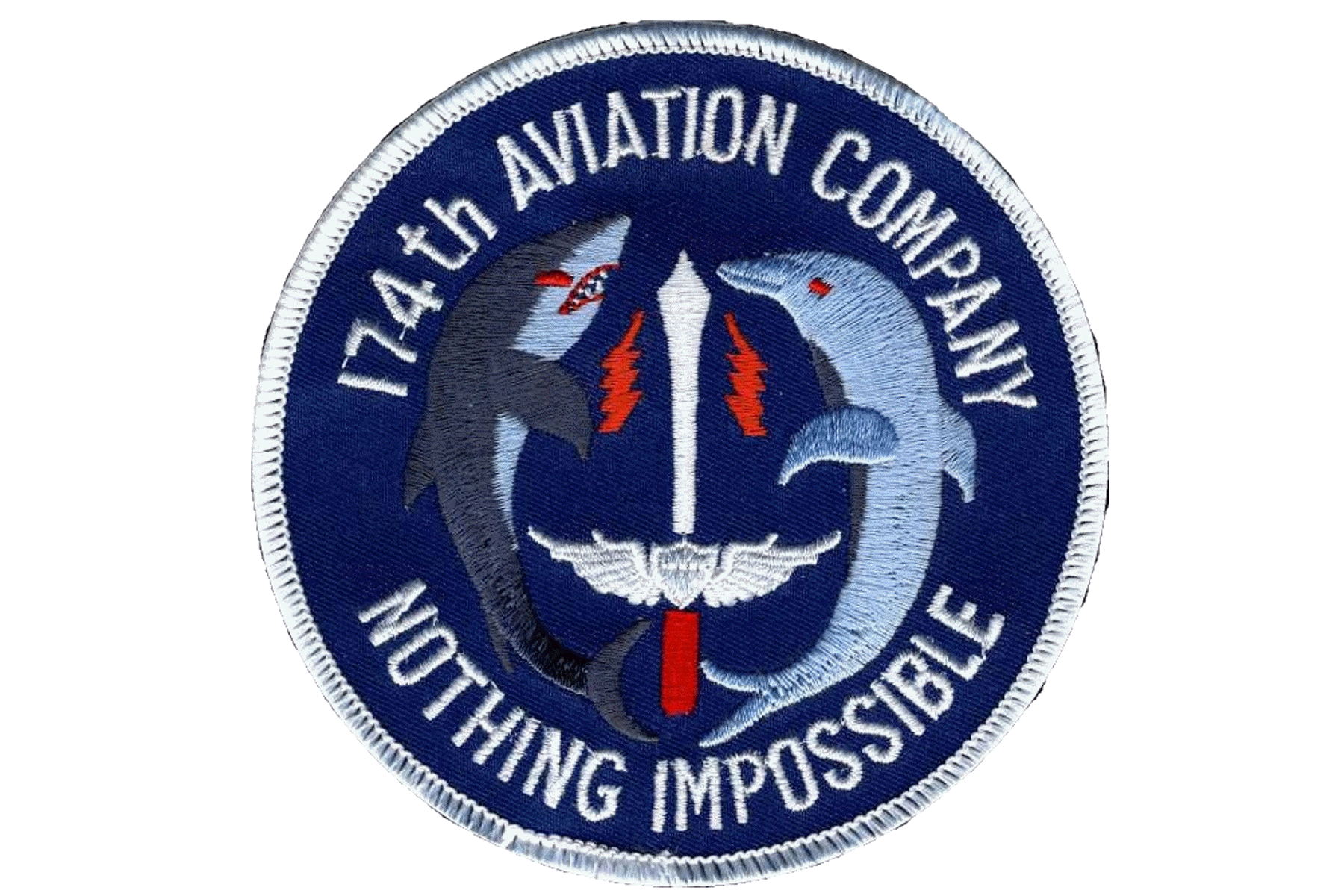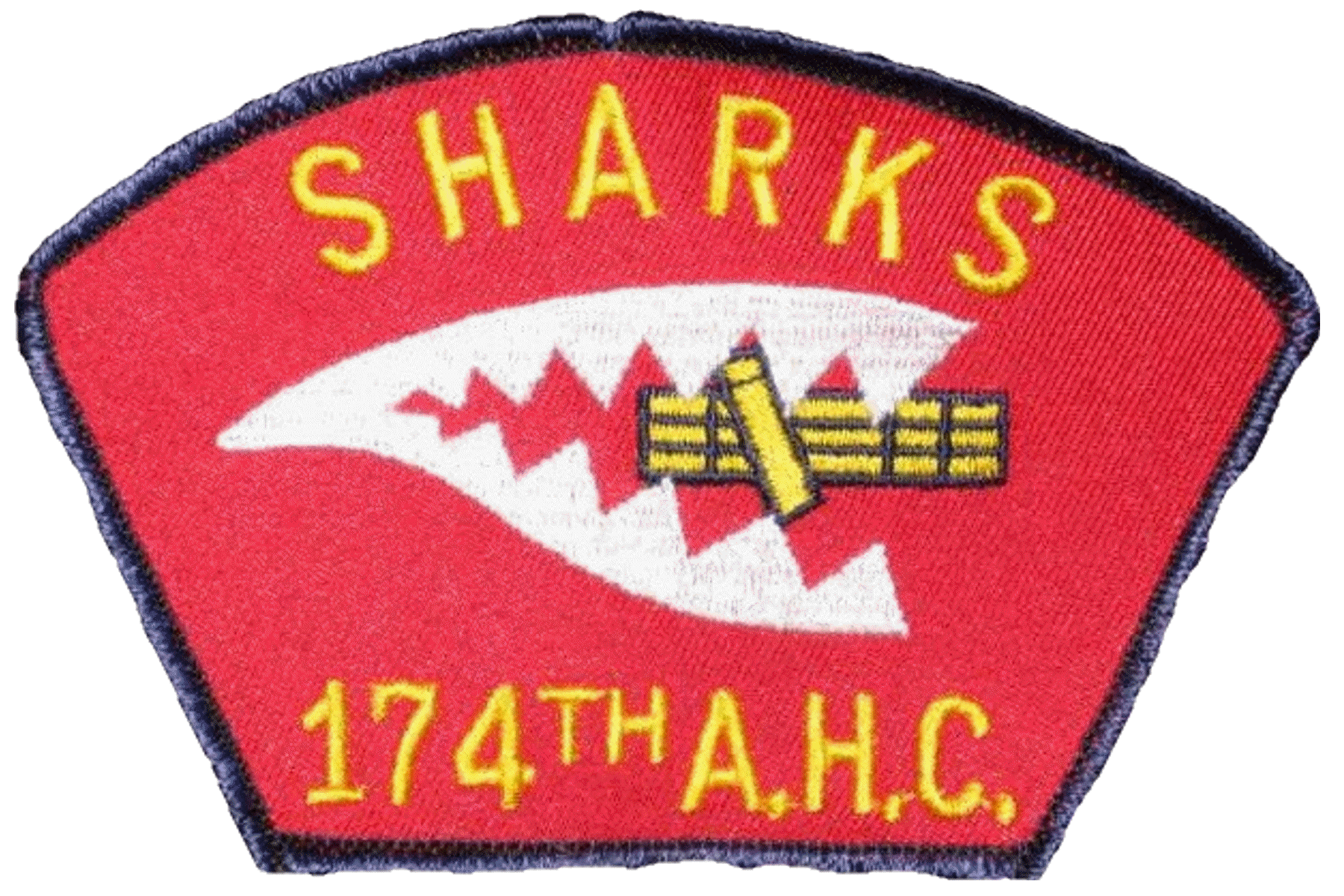A Vietnam Retrospective
PART 5
Click on the blue cube to go back to Part 4
 ==========================
==========================
In early September 1970 there was a flash fire at Quang Ngai POL (Petroleum, Oil, and Lubricants) that sent a Shark gunner, A.C. Copeland and the aircraft commander, WO Tony Spanier, home earlier than scheduled. The burns they received were not life threatening, but the fear of infection got them out of the combat zone. The crewchief, Fred Carlson and pilot Bruce Marshall were uninjured.
On September 8, Fred Carlson was hit seriously by .51 Caliber fire and it was feared he would lose his leg. On September 28 I was flying on a large combat assault west of Hill 411, into Happy Valley. We were just north of DFC Meadows, at the mouth of the valley. I recall being at about 2500 feet with troops and looking down, out the left side of the aircraft at our escorts, the Musket gunships, cruising almost lazily west bound, low level, just ahead of the flight. It was almost surreal to watch a large, gray puff of smoke exit the exhaust of a Musket aircraft and watch it, as in slow motion, dip nose down and invert, falling through the jungle canopy out of view. 176 AHC Warrant Officers, Ted Sizemore, Petty, and their crew perished that day. They had been buddies to my best friend, Scott Reed of the Muskets. Another indelible view that lives here within me.
On any given day or night, a slick pilot could be assigned any number of varying missions.
Outside of the standard combat assaults and resupply, were "night flare standby,"' psyops
(psychological operations), and "people sniffer" missions.
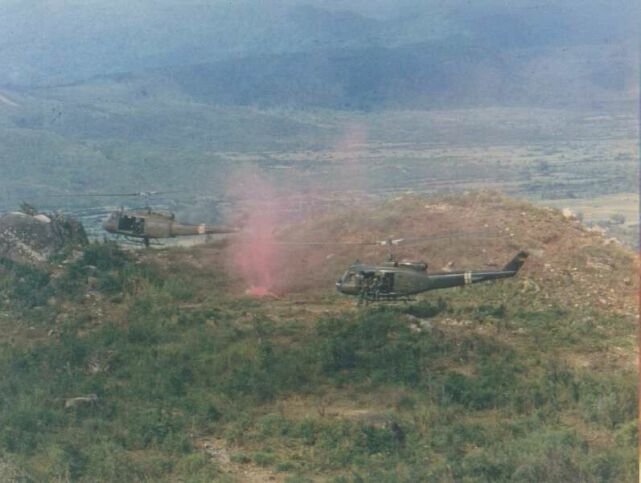 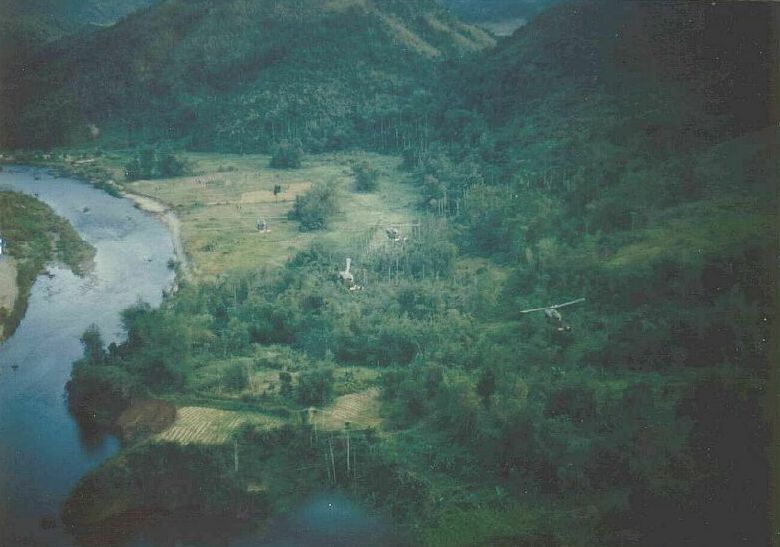
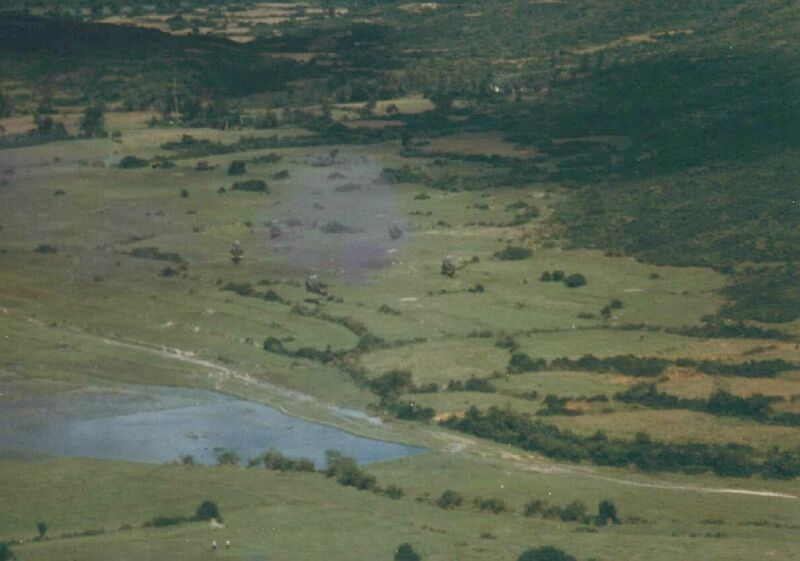
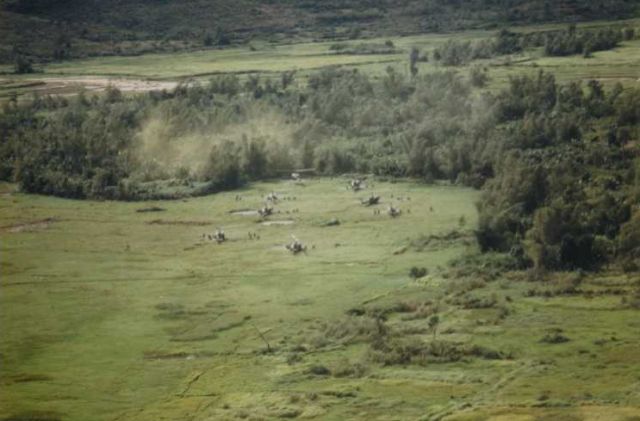
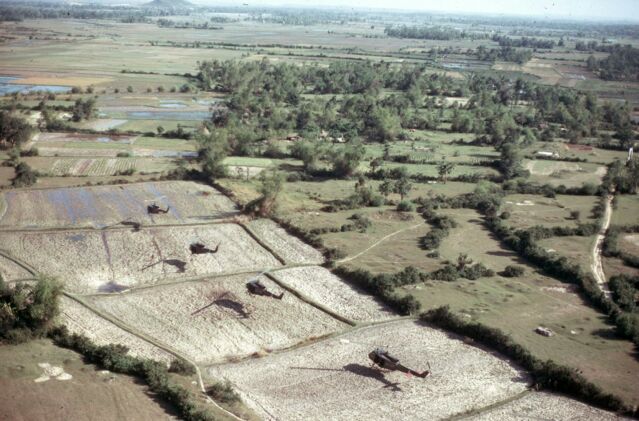
Above are five photos of 2, 4, 5 and 10 ship CAs (extraction
or insertion) 1970.
As a night flare pilot, you'd pre-flight and load a Dolphin H-Model with aerial flares and pretty much hang out with the Shark crews in the event of a night scramble. All the slick drivers were assigned these missions on a rotating basis. It was almost nightly that any one of these rotating responsibilities could keep an aviator from over indulging in the O club.
The image many pilots presented as hard drinking Vikings was, at times, a little over
exaggerated and not quite realistic. On my first scramble as a flare ship, some grunts
were getting sniped and mortared at the foothills, just west of Minh Long, not far from
Duc Pho. Because the friendly location was so near sea level, we flew our mission at about
2000 feet, giving us an almost surreal view of the action below. The crew would set the
flare fuses to ignite at a certain altitude above the identified enemy location and we'd fly
this circular pattern and dump the things out. From above, it created the appearance of a
giant, sinking birthday cake with the Sharks flying about low-level, appearing as moths, as
they looked for and engaged the enemy positions.
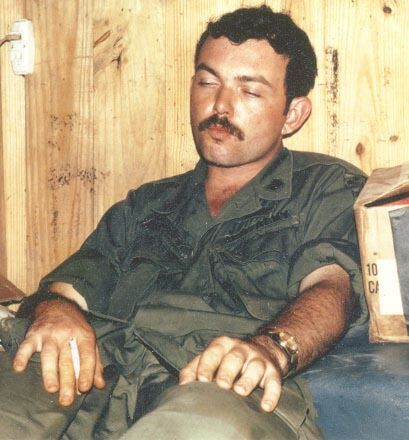 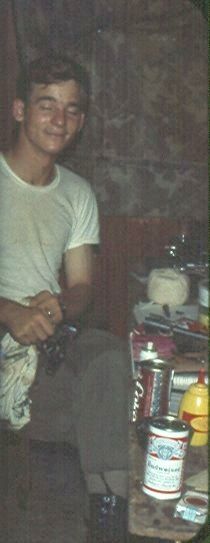 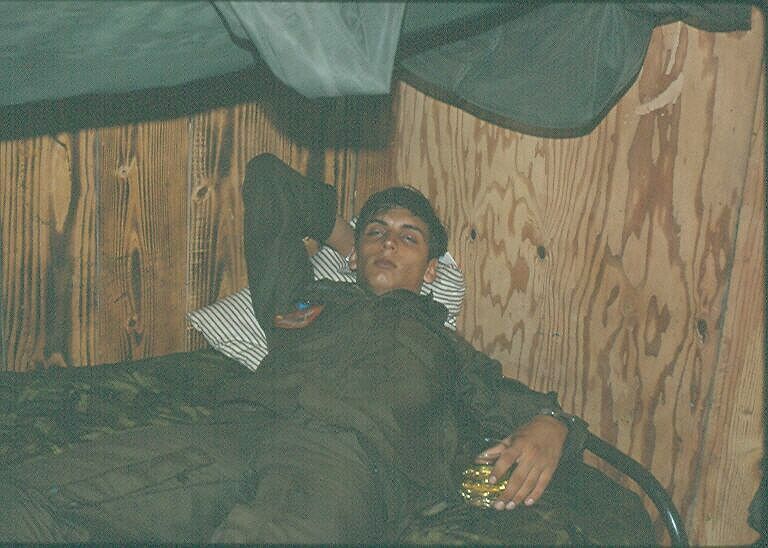 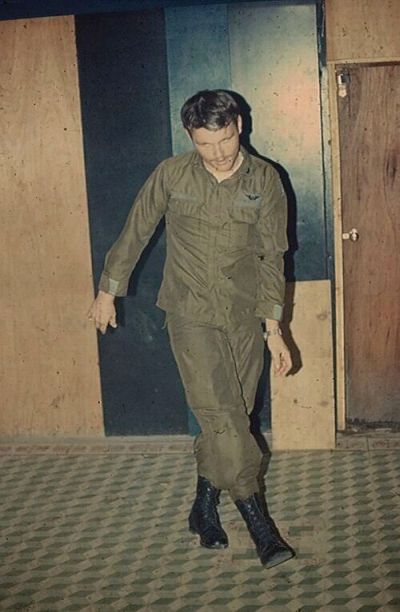
The photos above are a few “hard drinking Vikings” 1970. No names here, to protect the innocent.
The sniffer mission included a special device installed in the aircraft that came along with
a specialist to operate it. You'd fly real low and slow over real nasty, scary jungle locations with the idea that the guy in back could tell when you were in the area of measurable human urine. Another, more immediate indicator of enemy troops was the intensity of Charlie's projectiles ripping through the cargo bay floor.
The Psyops missions were of equal curiosity. They generally took place under the cloak of darkness (for protection of the crew). Again, flying low and slow over the designated villes, about midnight, the specialist in the back would fire up the reel-to-reel tape deck to saturate the target area with the high pitched, ARVN sales pitch to Chui Hoi (or surrender) your weapons to our way of thinking. In addition, boxes of paper leaflets would be dropped as confetti to completely litter the entire area.
Is it any wonder why there were so many Viet Cong? That annoying and antisocial behavior in itself almost had me change over to become a communist. This desperation and waste of material must have been the absolute result of some REMF (who was obviously promoted much too quickly). Can you imagine any entity, government or private, attempting to pull some nonsense like that over your neighborhood, at night, in the States? The countryside would be littered with burning helicopters. I was beginning to understand the source of the far away gaze. Fortunately for most of the pilots and crews of the 174th, the resupply missions to the companies of the 11th LIB were the bulk of the missions. Landing outside little villes or on a mountain trail to deliver and pick up anything and everything. My first encounter with a water buffalo on one hot afternoon had me convinced that the worst odor known to man comes off those powerful beasts.
On October 11, during a combat assault on the "Horseshoe," one of the Dolphin slicks experienced an engine failure on final to the LZ. The AC completed a picture-perfect autorotation with no injury to crew or aircraft. However, in the excitement of the moment, one of the grunts felt he had a better chance of survival "outside" the aircraft prior to touchdown. The pack-laden individual jumped and compound-fractured one of his legs.
Dave Rosenthal and Pete Goodnight were flying the trail aircraft and upon dumping their packs, moved over to the disabled aircraft and prepared to load the crew and the wounded man for evacuation. One of the crew inadvertently leaned his "butterfly handled" m-60 (still loaded) against the back of Pete's pilot chair. They flew the wounded man to Hill 411 where medics felt they were unequipped to aid the injured troop. During the re-loading of the wounded individual, someone attempted to move the firearm behind Pete's chair to accommodate the shuffle.
The butterfly rod, on the bottom of the weapon hung up on the aluminum map case on the back of the console and approximately three rounds discharged into the back of Pete's head, killing him instantly. Oh, but for the grace of God go we... Pete had returned from burying his younger brother after a car accident in San Diego just weeks before. He had a premonition that he wasn't going to make it out and I was with him when he wrote a poem about it. He stuck the poem in between some rocket boxes in my old room in the misfits. After he was killed, I retrieved the poem and Major Searcy read it at the memorial service we held for him in the outdoor maintenance tent that night. The benches for seating were damaged blades from the Shark Charlie-models.
Fred Thompson and Pete (Ray) Goodnight, June/July 1970.
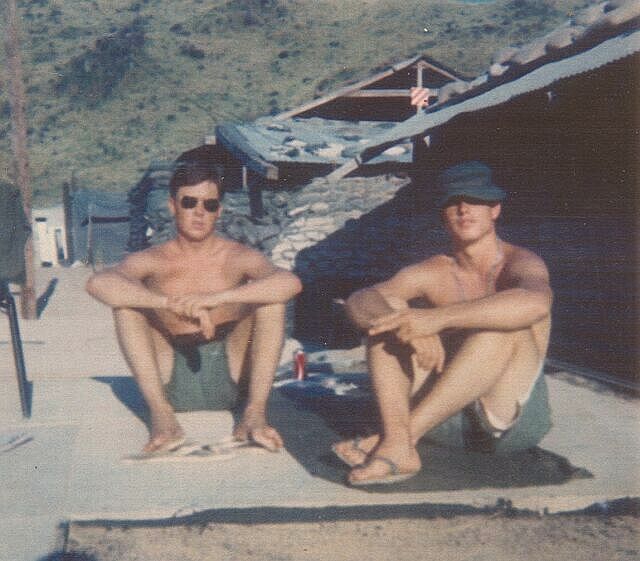
------------------------
End of Part 5 of 20 Parts.
Click on the beacon to go to Part 6

|
